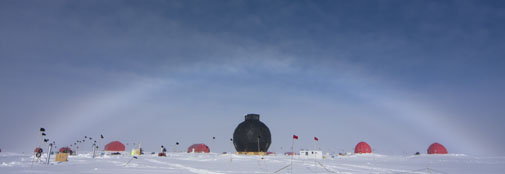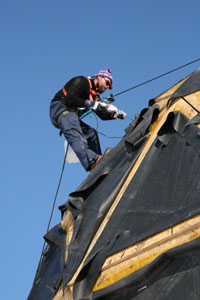The NEEM camp is ready for ice drilling - almost

The last people have left NEEM for this year. Since May, 60 people from Holland, USA, England, Australia, Southkorea, Iceland, France, Switzerland, Germany, Greenland and Denmark have worked hard to construct the camp. By the end of the season, camp construction is almost finished. NEEM is ready for the next 3-4 years of research into the climate of the past
The barren inland ice was what met the first people arriving at the NEEM site in May this year. The construction of the NEEM camp started from scratch, and during the summer the camp has taken shape. Scientists from Centre for Ice and Climate and the international NEEM partners have worked with the construction of the camp together with mechanics, electronic engineers, plumbers, carpenters, cooks, and doctors. The main dome has been completed, containing all the common facilities (bath, toilet, kitchen and laundry), living space, and the office. Two garages and two big tents for accommodation have been raised. For the scientific work, 6.5 meters deep science and drill trenches have been excavated and covered with a wooden roof.
The plan was that the deep drill, which is going to drill 2500 meters through the icecap, should have been installed as well, but because of problems with the control system the installation has to wait until next year. But everything is ready for the deep drill, and with a smaller drill the first 100 meters of ice core has been retrieved. The uppermost 80-100 meters of the ice sheet consists of the porous firn-layer. To prevent the drilling liquid, which is necessary for the deep drilling operation, to flow out into the firn, the hole is lined with a casing. The retrieved ice cores have been logged, and samples have been cut for isotope-measurements. Moreover measurements of the electrical conductivity of the ice have been made. In the drilling trench, a control cabin has been build and the drill tower has been raised. An 8.5 meters deep inclined trench, into which the drill tower turns when sending the drill into the hole, has been excavated. The deep drill is constructed by engineers, mechanics and glaciologists from the Niels Bohr Institute.
The first scientific work at NEEM
The first season at NEEM has not only been about construction of the camp, there has also been time for research. In addition to the first 100 meters of ice cores from the deep drilling operation, another three 80 meter-ice-cores have been extracted. These drill holes have been used by European and American researchers for sampling the gas trapped between the snow crystals. On the surface of the ice sheet, radar experts from CReSIS in Kansas, USA, have made a 10 by 10 km net of measurements around the NEEM site. The measurements make it possible to determine the age of the ice, the movements of the ice, the depth of interne layers and the bottom of the ice sheet.

The construction of the main dome was more difficult than expected and therefore the building was finished in August instead of as planned in the end of May.
A weather station was located near NEEM, and has been moved closer to the camp. The data about the weather conditions around NEEM for the last three years was downloaded. With these data the researchers can get a picture of the current climate conditions and compare them with the data from the newly retrieved ice cores.
Moreover, a seismic station operated by the Geological Survey of Denmark and Greenland was placed near the camp. The station has been checked and moved to the science trench. The seismic data have been downloaded, and will provide information on the bedrock conditions under the ice sheet.
Closing down for the winter
After the intensive work all summer in the camp, the last 15 people left the NEEM site on August 19. Before then, the camp was closed down for the winter: All vehicles were driven into the garages. The science trench and drilling trench were closed with chip boards to prevent snow from getting in. The generator was towed away from the main dome to limit snowdrifts. The entrance to the main dome was closed with chip boards, and all water systems in the building were drained to prevent frost cracking of the pipes. All electronic systems were taken down and moved to the science trench because they cannot stand the cold. In main dome the temperature during the winter may reach - 60oC, but in the science trench the temperature will "only" reach -30oC because of the insulation by the snow. The two smallest accommodation tents were taken down while the small fiber glass domes - the so-called "Tomatoes" - together with fuel and other cargo were towed up on artificial snow hills to prevent them from being covered by snow drifts. Everything left in the camp was documented so it can be registered in the logistic database.
Now the winter is on it's way and the work with the NEEM project will continue at Centre for Ice and Climate. Before the NEEM camp reopens next summer, the deep drill is going to be repaired and tested. The scientific work is going to be prepared, so the glaciologists are ready to perform measurements on the many hundred meters of ice core that are going to be retrieved next year. From the three 80 meter ice cores, 10.000 isotope samples have already been cut. With the isotope measurements the researchers are able to date the ice cores and determine the climate history at the NEEM site for the last 300 years. These measurements should be ready before the researchers return to NEEM in May 2009. These 300 years of climate history represent the beginning of the more than 130,000 years of climate record that the NEEM project will produce - a record waiting for us 2500 meters further down in the ice sheet.
